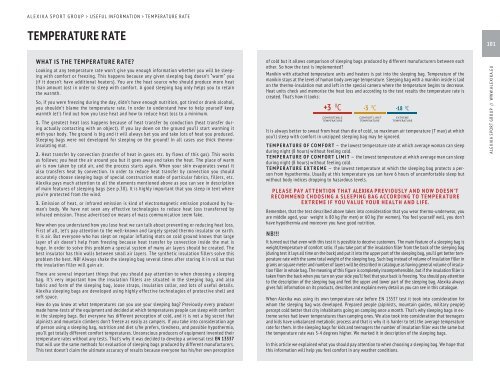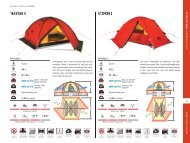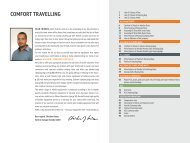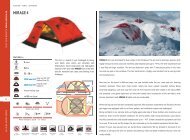Create successful ePaper yourself
Turn your PDF publications into a flip-book with our unique Google optimized e-Paper software.
ALEXIKA SPORT GROUP > USEFUL <strong>IN</strong>FORMATION > TEMPERATURE RATE<br />
TEMPERATURE RATE<br />
101<br />
WHAT IS THE TEMPERATURE RATE<br />
Looking at any temperature rate won’t give you enough information whether you will be sleeping<br />
with comfort or freezing. This happens because any given sleeping bag doesn’t “warm” you<br />
(if it doesn’t have additional heaters). You are the heat source who should produce more heat<br />
than amount lost in order to sleep with comfort. A good sleeping bag only helps you to retain<br />
the warmth.<br />
So, if you were freezing during the day, didn’t have enough nutrition, got tired or drank alcohol,<br />
you shouldn’t blame the temperature rate. In order to understand how to help yourself keep<br />
warmth let’s find out how you lose heat and how to reduce heat loss to a minimum.<br />
1. The greatest heat loss happens because of heat transfer by conduction (heat transfer during<br />
actually contacting with an object). If you lay down on the ground you’ll start warming it<br />
with your body. The ground is big and it will always bet you and take lots of heat you produced.<br />
Sleeping bags were not developed for sleeping on the ground! In all cases use thick thermoinsulating<br />
mat.<br />
2. Heat transfer by convection (transfer of heat in gases etc. by flows of this gas). This works<br />
as follows; you heat the air around you but it goes away and takes the heat. The place of warm<br />
air is now taken by cold air, and the process starts again. When your skin evaporates sweat it<br />
also transfers heat by convection. In order to reduce heat transfer by convection you should<br />
accurately choose sleeping bags of special construction made of particular fabrics, fillers, etc.<br />
Alexika pays much attention to all the elements mentioned above as you can see in description<br />
of main features of sleeping bags (see p.30). It is highly important that you sleep in tent where<br />
you’re protected from the wind.<br />
3. Emission of heat, or infrared emission is kind of electromagnetic emission produced by human’s<br />
body. We have not seen any effective technologies to reduce heat loss transferred by<br />
infrared emission. Those advertised on means of mass communication seem fake.<br />
Now when you understand how you lose heat we can talk about preventing or reducing heat loss.<br />
First of all, let’s pay attention to the well-known and largely spread thermo insulator on earth.<br />
It is air. But everyone who has slept on regular inflating mats on cold ground knows that large<br />
layer of air doesn’t help from freezing because heat transfer by convection inside the mat is<br />
huge. In order to solve this problem a special system of many air layers should be created. The<br />
best insulator has thin walls between small air layers. The synthetic insulation fillers solve this<br />
problem the best. NB! Always shake the sleeping bag several times after storing it in roll so that<br />
the insulation filler will gain air.<br />
There are several important things that you should pay attention to when choosing a sleeping<br />
bag. It’s very important how the insulation fillers are situated in the sleeping bag, and also<br />
fabric and form of the sleeping bag, loose straps, insulation collar, and lots of useful details.<br />
Alexika sleeping bags are developed using highly effective technologies of protective shell and<br />
soft space.<br />
How do you know at what temperatures can you use your sleeping bag Previously every producer<br />
made home-tests of the equipment and decided at which temperatures people can sleep with comfort<br />
in the sleeping bags. But everyone has different perception of cold, and it is not a big secret that<br />
alpinists and mountain climbers don’t freeze as easily as campers. If you take into consideration age<br />
of person using a sleeping bag, nutrition and diet s/he prefers, tiredness, and possible hypothermia,<br />
you’ll get totally different comfort temperatures. Unconscious producers of equipment invented their<br />
temperature rates without any tests. That’s why it was decided to develop a universal test EN 13537<br />
that will use the same methods for evaluation of sleeping bags produced by different manufacturers.<br />
This test doesn’t claim the ultimate accuracy of results because everyone has his/her own perception<br />
of cold but it allows comparison of sleeping bags produced by different manufacturers between each<br />
other. So how the test is implemented<br />
Manikin with attached temperature units and heaters is put into the sleeping bag. Temperature of the<br />
manikin stays at the level of human body average temperature. Sleeping bag with a manikin inside is laid<br />
on the thermo-insulation mat and left in the special camera where the temperature begins to decrease.<br />
Heat units check and memorize the heat loss and according to the test results the temperature rate is<br />
created. That’s how it looks:<br />
+3 0 С -3 0 С -18 0 С<br />
<strong>COMFORT</strong>ABLE<br />
TEMPERATURE<br />
<strong>COMFORT</strong> LIMIT<br />
TEMPERATURE<br />
EXTREME<br />
TEMPERATURE<br />
It is always better to sweat from heat than die of cold, so maximum air temperature (T max) at which<br />
you’ll sleep with comfort in unzipped sleeping bag may be ignored.<br />
TEMPERATURE OF <strong>COMFORT</strong> — the lowest temperature rate at which average woman can sleep<br />
during night (8 hours) without feeling cold.<br />
TEMPERATURE OF <strong>COMFORT</strong> LIMIT — the lowest temperature at which average man can sleep<br />
during night (8 hours) without feeling cold.<br />
TEMPERATURE EXTREME — the lowest temperature at which the sleeping bag protects a person<br />
from hypothermia. Usually at this temperature you can have 6 hours of uncomfortable sleep but<br />
without body indices dropping to hazardous levels.<br />
PLEASE PAY ATTENTION THAT ALEXIKA PREVIOUSLY AND NOW DOESN’T<br />
RECOMMEND CHOOS<strong>IN</strong>G A SLEEP<strong>IN</strong>G BAG ACCORD<strong>IN</strong>G TO TEMPERATURE<br />
EXTREME IF YOU VALUE YOUR HEALTH AND LIFE.<br />
Remember, that the test described above takes into consideration that you wear thermo-underwear, you<br />
are middle aged, your weight is 80 kg (for men) or 60 kg (for women). You feel yourself well, you don’t<br />
have hypothermia and moreover you have good nutrition.<br />
N B!!!<br />
It turned out that even with this test it is possible to deceive customers. The main feature of a sleeping bag is<br />
weight/temperature of comfort ratio. If you take part of the insulation filler from the back of the sleeping bag<br />
(during test it lays all time on the back) and put it into the upper part of the sleeping bag, you’ll get better temperature<br />
rate with the same total weight of the sleeping bag. Such bag instead of volume of insulation filler in<br />
grams on square meter and number of layers will be described in catalogue as having general volume of insulation<br />
filler in whole bag. The meaning of this figure is completely incomprehensible, but if the insulation filler is<br />
taken from the back when you turn on your side you’ll feel that your back is freezing. You should pay attention<br />
to the description of the sleeping bag and feel the upper and lower part of the sleeping bag. Alexika always<br />
gives full information on its products, describes and explains every detail as you can see in this catalogue.<br />
When Alexika was using its own temperature rate before EN 13537 test it took into consideration for<br />
whom the sleeping bag was developed. Prepared people (alpinists, mountain guides, military people)<br />
percept cold better that city inhabitants going on camping once a month. That’s why sleeping bags in extreme<br />
series had lower temperatures than camping ones. We also took into consideration that teenagers<br />
and kids have unbalanced metabolic process and that is why it is harder to tell the average temperature<br />
rate for them. In the sleeping bags for kids and teenagers the number of insulation filler was the same but<br />
the temperature rate was 3-4 degrees higher. We marked it in description of the sleeping bags.<br />
In this article we explained what you should pay attention to when choosing a sleeping bag. We hope that<br />
this information will help you feel comfort in any weather conditions.<br />
ALEXIKA SPORT GROUP // WWW.ALEXIKA.EU









